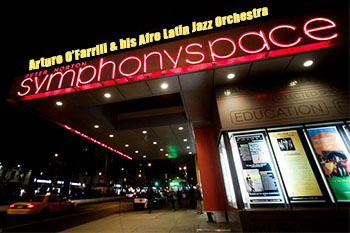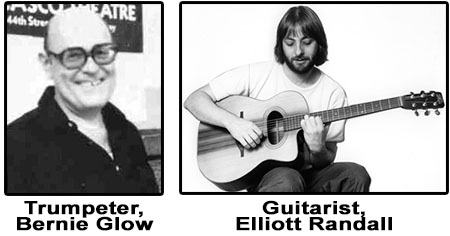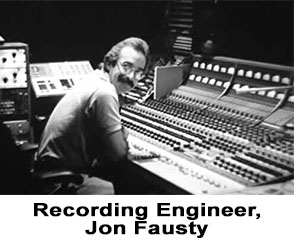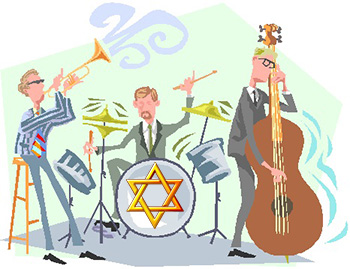There is a strong and direct relationship between jazz, Latin-jazz and people of Jewish cultural background that has its roots as far back as the 1920s.
While in London over the summer of 2013—in addition to visiting several of the leading jazz clubs in the Greater London area, and before leaving the home of my birth and traveling on the EuroStar to Paris through the Chunnel—I had the opportunity to meet with author and radio broadcaster Michael Gerber. Gerber spent many years researching and writing a book on Jazz Jews (Five Leaves Publications, Nottingham, England, 2009). His book is no narrow scope volume. It is a tome: 23 chapters, 656 pages in all, including the bibliography and index. It’s divided into three parts: The USA, Worldwide, and Fusions and Conclusions.
Gerber’s book is an excellent, highly detailed, and definitive work. Suffice it say there is a strong relationship between jazz, popular music and Jews on a global scale, but especially in the United States. To pick an obvious example, Irving Berlin, a Jew, wrote “I’m Dreaming of a White Christmas.”
Another instance: it is a little known fact that three Jews renovated the famed Apollo Theatre in Harlem where many jazz greats perform and have performed.
From the Apollo’s own history web site (http://www.apollotheater.org/about/history):
The neo-classical theater known today as the Apollo Theater was designed by George Keister and first owned by Sidney Cohen. In 1914, Benjamin Hurtig and Harry Seamon obtained a thirty-year lease on the newly constructed theater calling it Hurtig and Seamon’s New Burlesque Theater. Like many American theaters during this time, African-Americans were not allowed to attend as patrons or to perform.
In 1933 Fiorello La Guardia, who would later become New York City’s Mayor, began a campaign against burlesque. Hurtig & Seamon’s was one of many theaters that would close down. Cohen reopened the building as the 125th Street Apollo Theatre in 1934 with his partner, Morris Sussman serving as manager. Cohen and Sussman changed the format of the shows from burlesque to variety revues and redirected their marketing attention to the growing African-American community in Harlem. Frank Schiffman and Leo Brecher took over the Apollo in 1935. The Schiffman and Brecher families would operate the Theater until the late 1970s.
The relationship between jazz, Latin-jazz and Jews continues further downtown at Symphony Space on Manhattan’s upper Westside. In early November 2012, Arturo O’Farrill and his Afro Latin Jazz Orchestra presented an evening of “Falafel, Freilach, and Frijoles: Examining the Relationship between Jewish and Latino Communities Through Music.” Of this concert, O’Farrill commented:
“Latinos are in a similar position to which the Jews were in the past. They are not seen as part of society, even though we are. In this regard, we share the disposition and I also  think that in any way we can be called a diaspora culture, because we are not in our own land, we have been away from our culture.”
think that in any way we can be called a diaspora culture, because we are not in our own land, we have been away from our culture.”
O’Farrill explains that during the years between 1950 and 1970, a large number of people of Jewish origin used to vacation frequently in the region of Borscht Belt, located to the North of the State of New York, and there met with Latin bands led by figures such as Tito Puente and Eddie Palmieri. This meeting produced in Jews to develop a taste for rhythms like mambo. (http://www.afrolatinjazz.org/blog/?m=201210)
The Jews, jazz, and Latin-jazz cultural connection goes beyond the audience. There are many, many Jewish musicians who have and are players of the music, especially Latin-jazz. Here’s a sample:
Aaron Sachs (tenor)
Aaron Sachs (born July 4, 1923 New York City), is a well-known jazz saxophone and clarinet player. Sachs started as a young swing protégé of Benny Goodman, and later eased into bebop music, playing with Earl Fatha Hines. He then formed his own bands, with some success recording and touring. In the 1960s, Aaron Sachs went into Latin music, playing with the greats of that genre, including Machito, Tito Puente, and Tito Rodriguez. Aaron Sachs wrote a hit song for Tito Rodriguez, titled “El Mundo De Las Locas” and composed for drum legend Louis Bellson, with the mainstay tune “Blast off”. He also co-wrote a popular song for bandleader Machito with Henry Glover during the twist dance craze titled “Twist Changa” (parts one and two) a double a-sided single in 1959, on Roulette records.
 Irving Fields (piano)
Irving Fields (piano)
(B. August 4, 1915, New York City) Best known for his ability to turn almost any topic into ivory-tickled cocktail kitsch, Fields also claims status as a genuine jazz-fusion pioneer. His 1959 album “Bagels & Bongos” started not only a furor for Jewish-inflected Latin jazz (the album sold two million units), but launched a trend in popular music that opened the field to all manner of fusion experiments. Fields himself followed up his classic disc with “Pizzas & Bongos,” “Champagne & Bongos” and “Bikinis & Bongos,” the swaying lilt of Hawaiian music in the latter colliding with the propulsive rhythms of Latin.
Charles Fox (piano)
(Born October 30, 1940, New York, NY) is an American composer for film and television. His most heard compositions are probably the “love themes,” and the dramatic theme music to “ABC’s Wide World of Sports” and the original “Monday Night Football.”
His career started by playing the piano for, composing and arranging for artists such as Ray Barretto, Joe Quijano, and Tito Puente. He also wrote theme music and arranged for Skitch Henderson and “The Tonight Show” orchestra. Fox worked under the banner of Bob Israel’s Score Productions where he composed the themes for several Goodson-Todman game shows. He co-composed the theme song and all the original scores for “Love, American Style,” along with Arnold Margolin. Fox also co-composed “Killing Me Softly with His Song” with Norman Gimbel in 1972 which became an international #1 hit for Roberta Flack in 1973 and again for “The Fugees” in 1997. (The song won the Grammy for Best Song 1973). Fox & Gimbel later wrote the themes for many films such as “Last American Hero.”
Bernie Glow
(Born February 6, 1926 New York City; d. 1982 New York City) was a trumpet player who specialized in jazz and commercial lead trumpet from the 1940s to 1970s. His early career was on the road with Artie Shaw, Woody Herman and others during the last years of the big-band era. The majority of his years were spent as a first-rate NYC studio musician, where he  worked with Miles Davis and Frank Sinatra, and did thousands of radio and television recording sessions.
worked with Miles Davis and Frank Sinatra, and did thousands of radio and television recording sessions.
Elliott Randall
Elliott Randall (Born 1947) is an American guitarist, best known for being a session musician with popular artists. Randall played the well-known guitar solos from Steely Dan’s song “Reelin’ in the Years” and the theme song from “Fame.” It was reported that Led Zeppelin guitarist Jimmy Page said Randall’s solo on “Reelin’ in the Years” is his favorite guitar solo of all-time. The solo was ranked as the 40th best guitar solo of all-time by the readers of Guitar World magazine and the 8th best guitar solo by Q4 Music.
Bob Crawford
(Born in the Bronx, NY) is one of those rare people combining musicality, scholarship, and business acumen into one seamless individual. From being the Musical Director, Guitarist, and Vocalist for the National Company of Paul Sills’ “Story Theatre”(1972-3) to the publishing of his book “Symmetric Cycles” by RMCO MUSIC, Bob has been actively involved in songwriting, arranging, producing, and studio work as a guitarist and vocalist for the past 30 years. In 1975, Bob founded Josandra Rehearsal Studios in NYC which became the home of such celebrated musicians as Pat Martino, Larry Harlow, Sonny Rollins, Horace Silver, Mongo Santamaria, Slide Hampton, Sam Jones, Tom Harrell, Kevin Eubanks, Larry Coryell, John Abercrombie, Brand X, Tom Rush, and John Hammond among many others. In 1991, Larry Harlow (2008 Grammy Lifetime Achievement Award Winner and Latin Music Hall of Fame Member) recorded “My Time Is Now”(“Mi Tiempo Llego”) on the album of the same name, co-written by Bob Crawford and A. Dennis (Doc) Williams of the O’Jays released on Cache/Fania Records. In 2006, Maxine Brown (R&B Hall of Fame Member and Tony Award Winner) recorded another of Bob’s compositions “I Want to Be Loved” released on “From the Heart” (Mee Max Music, Inc.) He continues to write, publish, and place songs with other artists to this day.
Jon Fausty (recording engineer)
 Jon Fausty is a master recording engineer/producer, with a career that spans 33 years of professional experience within “state-of-the-art” technology, combined with acknowledge and a feeling for music that makes him sought after by artists and producers alike. Within the area of Latin music and jazz he is extremely well-respected and is considered to be perhaps the best recording engineer in these fields.
Jon Fausty is a master recording engineer/producer, with a career that spans 33 years of professional experience within “state-of-the-art” technology, combined with acknowledge and a feeling for music that makes him sought after by artists and producers alike. Within the area of Latin music and jazz he is extremely well-respected and is considered to be perhaps the best recording engineer in these fields.
There are dozens more Jews, just in the New York City area, such as Larry Harlow, who are associated with jazz and Latin-jazz. They will be featured in future blogs.
Please write to me at meiienterprises@aol.com if you have any comments on this or any other of my blogs.
Eugene Marlow, Ph.D.
February 17, 2014
© Eugene Marlow 2014


